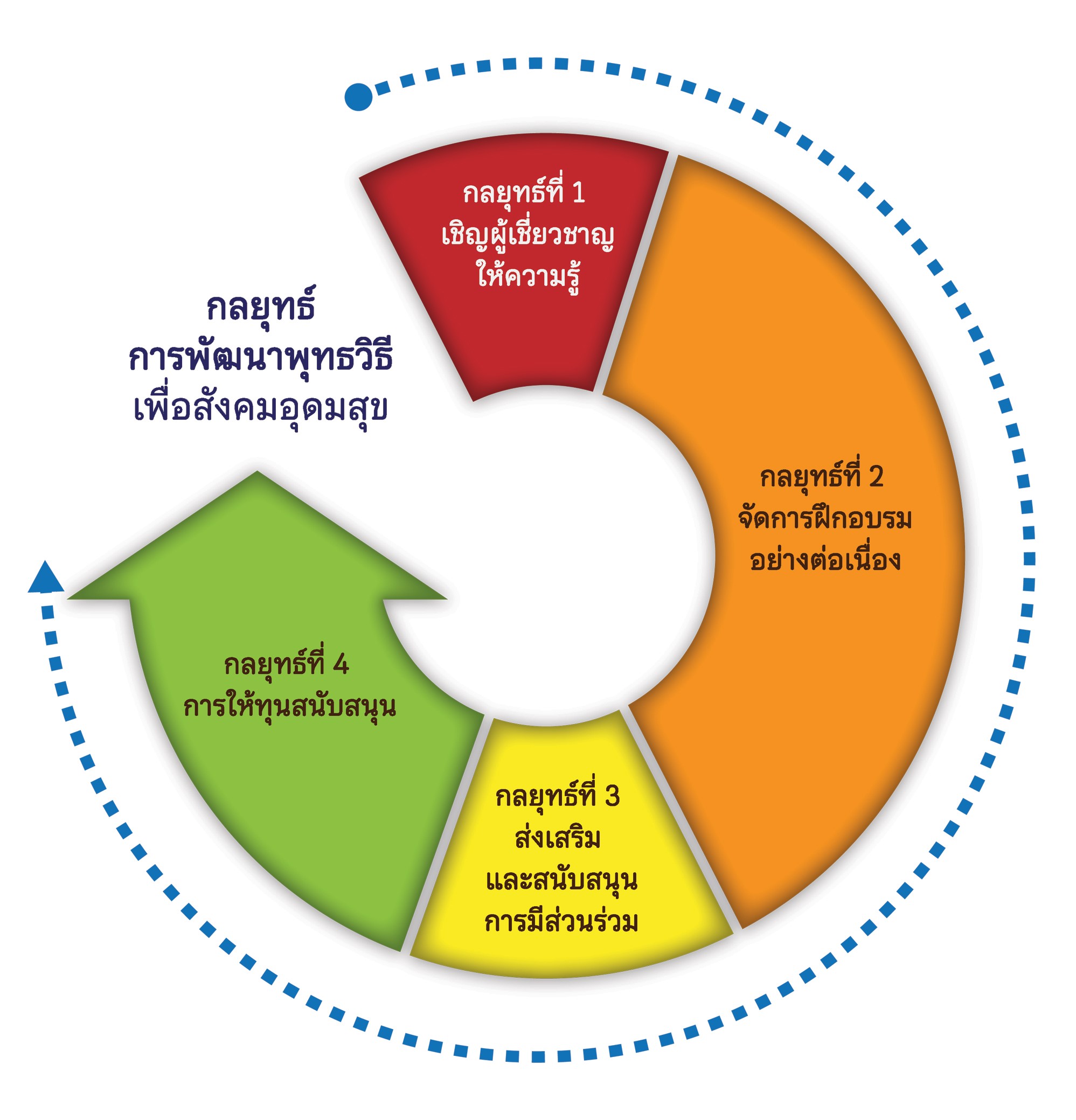The Development Strategy of Buddhist Method for Happiness Society for the Elderly People, Roi Et Province
Main Article Content
Abstract
The purposes of this research were 1) The Development Strategy of Buddhist Method for Happiness Society for the Elderly People, Roi Et Province, and 2) evaluate this strategy. The sample group for this study consisted of elderly individuals from the Mueang district of Roi Et province. This was a mixed method research. The researcher specifically chose a sample group consisting of seniors who face health-related issues, lifestyle challenges, and family-related problems. A total of 358 individuals were chosen. Data was collected through structured interviews from 9 respondents and evaluated by 17 qualified individuals. The research tools used included structured interviews, a questionnaire regarding problem conditions with 20 items. The statistics used for data analysis included frequency, percentage, mean, standard deviation, Pearson Product Moment Correlation (r), Multiple Regression Analysis (MR), and Descriptive Analysis.
The research results was found that:
1. The study on the condition, problems, and factors influencing the development strategy of Buddhist method for happiness society for the elderly people, Roi Et found that the age and gender of the elderly in Roi Et predict the factors affecting the development of the Buddhist approach for an ideal society significantly (P-value = .000). These two variables explain the variance in factors affecting the development by 0.48 percent (R2 = .048). The forecast equation can be written in raw scores as: Y = 3.648 + -.054X1 + -.050X2.
2. The evaluation of the strategy for the Buddhist method for happiness society for the elderly people, Roi Et province is generally at a high level. The aspect with the highest opinions is appropriateness, followed by accuracy and feasibility. The aspect with the least opinions is practicality.
Article Details

This work is licensed under a Creative Commons Attribution-NonCommercial-NoDerivatives 4.0 International License.
เพื่อให้เป็นไปตามกฎหมายลิขสิทธิ์ ผู้นิพนธ์ทุกท่านต้องลงลายมือชื่อในแบบฟอร์มใบมอบลิขสิทธิ์บทความ ให้แก่วารสารฯ พร้อมกับบทความต้นฉบับที่ได้แก้ไขครั้งสุดท้าย นอกจากนี้ ผู้นิพนธ์ทุกท่านต้องยืนยันว่าบทความ ต้นฉบับที่ส่งมาตีพิมพ์นั้น ได้ส่งมาตีพิมพ์เฉพาะในวารสาร วิชาการธรรม ทรรศน์ เพียงแห่งเดียวเท่านั้น หากมีการใช้ ภาพหรือตารางของผู้นิพนธ์อื่นที่ปรากฏในสิ่งตีพิมพ์อื่นมาแล้ว ผู้นิพนธ์ต้องขออนุญาตเจ้าของลิขสิทธิ์ก่อน พร้อมทั้ง แสดงหนังสือที่ได้รับการยินยอมต่อบรรณาธิการ ก่อนที่บทความจะได้รับการตีพิมพ์References
กองวิชาการ และแผนงาน. (2565). แผนพัฒนาท้องถิ่น (พ.ศ. 2561-2565) เทศบาลเมืองร้อยเอ็ดอำเภอเมืองร้อยเอ็ดจังหวัดร้อยเอ็ด. ร้อยเอ็ด: งานวิเคราะห์นโยบายและแผน.
จริยา อินทรรัศมี. (2564). กระบวนการส่งเสริมการเรียนรู้ร่วมกันระหว่างผู้สูงอายุกับผู้ดูแล ในการปรับปรุงสิ่งแวดล้อมภายในและภายนอกบ้านของผู้สูงอายุจังหวัดร้อยเอ็ด และจังหวัดเลย. วารสารศูนย์อนามัยที่ 9: วารสารส่งเสริมสุขภาพและอนามัยสิ่งแวดล้อม, 15(36), 1-14.
จีรนันท์ อินทฉิม, ชุลี อัศวพิชยนต์ และศรีนวล วิหครัตน์. (2551). การดำเนินการพัฒนาในด้านเมืองน่าอยู่อย่างยั่งยืนของเทศบาลเมืองพิจิตร อำเภอเมือง จังหวัดพิจิตร. (การศึกษาค้นคว้าด้วยตนเองรัฐประศาสนศาสตรมหาบัณฑิต). พิษณุโลก: มหาวิทยาลัยนเรศวร.
บุญชม ศรีสะอาด และคณะ. (2551). พื้นฐานการวิจัยการศึกษา. กาฬสินธุ์: ประสานการพิมพ์.
บุญชม ศรีสะอาด. (2554). การวิจัยเบื้องต้น. (พิมพ์ครั้งที่ 9). กรุงเทพฯ: สุวีริยาสาส์น.
ศิลปสวย ระวีแสงสูรย์. (2560). แนวทางการพัฒนาคุณภาพการดูแลผู้สูงอายุของกรุงเทพมหานครเพื่อรองรับสังคมผู้สูงอายุ. (รายงานการวิจัย). กรุงเทพฯ: วิทยาลัยป้องกันราชอาณาจักร.
สิทธิพรร์ สุนทร, วัชรินทร์ สุทธิศัย และพงษ์ศักดิ์ ซิมมอนด์ส. (2561). รูปแบบความสุขของผู้สูงวัยในจังหวัดมหาสารคาม. (รายงานการวิจัย). มหาสารคาม: มหาวิทยาลัยราชภัฏมหาสารคาม.

